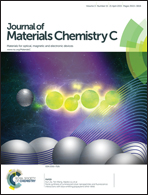Efficient OLEDs with low efficiency roll-off using iridium complexes possessing good electron mobility†
Abstract
Two bis-cyclometalated iridium complexes (Ir1 and Ir2) with trifluoromethyl substituted bipyridine (2′,6′-bis(trifluoromethyl)-2,3′-bipyridine (L1) and 2′,6′-bis(trifluoromethyl)-2,4′-bipyridine (L2)) as the main ligands and tetraphenylimidodiphosphinate as the ancillary ligand were prepared, and their X-ray crystallography, photoluminescence, electrochemistry properties were investigated. The Ir1 and Ir2 complexes show green emissions at about 500 and 502 nm with high quantum efficiencies of 0.63 and 0.93, respectively. Moreover, they also exhibit higher electron mobility than that of Alq3 (tris-(8-hydroxyquinoline)aluminium). The organic light emitting diodes (OLEDs) with the structure of ITO/TAPC (1,1-bis[4-(di-p-tolylamino)phenyl]cyclohexane, 40 nm)/mCP (1,3-bis(9H-carbazol-9-yl)benzene, 10 nm)/Ir complex (8 wt%): PPO21 (3-(diphenylphosphoryl)-9-(4-(diphenylphosphoryl)phenyl)-9H-carbazole, 25 nm)/TmPyPB (1,3,5-tri(m-pyrid-3-yl-phenyl)benzene, 50 nm)/LiF (1 nm)/Al (100 nm) showed excellent performances, partly due to their high quantum efficiency and high electron mobility. For the devices G1 and G2, the maximum current efficiency (ηc) values are as high as 101.96/99.97 cd A−1 and the maximum external quantum efficiencies of 31.6% and 30.5% with low electroluminescence efficiency roll-off. The ηc data still remain over 90 cd A−1 even at the luminance of 10 000 cd m−2, which proves that the complexes have potential applications as efficient green emitters in OLEDs.


 Please wait while we load your content...
Please wait while we load your content...